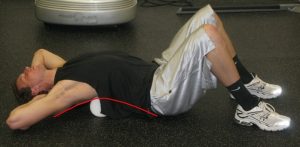Once we understand the importance of the Thoracic Spine on our athlete’s health, biomechanics, and performance, we have to understand how to evaluate it and then finally, treat it.
There are a variety of ways that you can go about evaluating the Thoracic Spine. At MTS, we try hard to keep it simple and straight forward. The evaluation tools we are presenting here are what we describe as “down and dirty”, for lack of a better term. They may not be the most specific or detailed, but in a mere few seconds you can gauge what kind of mobility an athlete has and how much you have to worry about addressing it.
These work great for “healthy” athletes who don’t have a history of a lot of shoulder or back pain or dysfunction. If you are working with an athlete with an injury or dysfunction, you likely should be addressing Thoracic Spine mobility anyway, so we have found that a super detailed evaluation isn’t all that important either
Thoracic Extension
Using a foam roll, place it at the level approximately T-11 to T-12. Bend the knees and keep the feet flat and hips on the floor. Place the hands behind the head and relax the shoulders back over the foam roll.

 Make sure the foam roll is placed in the proper place on the spine. If it is too low, you are simply evaluating lumbar spine extension (which most athletes with a T Spine extension restriction have too much of because of compensation). If it is too high, you won’t see any movement. The pivot point for the T Spine is actually at the bottom of the T Spine in the range of the 11th or 12th vertibrae.
Make sure the foam roll is placed in the proper place on the spine. If it is too low, you are simply evaluating lumbar spine extension (which most athletes with a T Spine extension restriction have too much of because of compensation). If it is too high, you won’t see any movement. The pivot point for the T Spine is actually at the bottom of the T Spine in the range of the 11th or 12th vertibrae.
The closer the shoulders are to the floor and larger the arch, the greater the athlete’s Thoracic Spine Extension.
Thoracic Rotation
 To assess Thoracic Rotation, the key is essentiall locking in every spot where rotation could occur in order to compensate for a lack of thoracic rotation. Once you do that, you isolate the Thoracic spine and you can get an accurate assessment.
To assess Thoracic Rotation, the key is essentiall locking in every spot where rotation could occur in order to compensate for a lack of thoracic rotation. Once you do that, you isolate the Thoracic spine and you can get an accurate assessment.
The easiest assessment for Thoracic Rotation is in a fully flexed and kneeling position. Reach out with one hand into full shoulder flexion. The other arm should be placed behind the back. Actively rotate the shoulders open as far as possible. This isolates the Thoracic Spine and demonstrates their ability to rotate. Obviously, the greater the shoulder rotation, the better the athlete’s Thoracic rotational mobility.
Learn more about how the Thoracic Spine affects other movements:
- Shoulder Health
- Shoulder Performance
- Overhead Movements
- Sport Specific Movements
- Overall Spinal Health
Learn about mobility of the T-Spine:


Leave a Reply